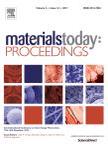版权所有:内蒙古大学图书馆 技术提供:维普资讯• 智图
内蒙古自治区呼和浩特市赛罕区大学西街235号 邮编: 010021

作者机构:Department of Automobile Engineering Rajalakshmi Engineering College Chennai 602105 India Department of Information Technology Dr. M.G.R. Educational and Research Institute Chennai 600095 India Schoolof Mechanical Engineeirng VIT Bhopal University Madhya Pradesh 466114 India Department of Mechanical Engineering Dr. M.G.R. Educational and Research Institute Chennai 600095 India Department of Mechanical Engineering Aarupadai Veedu Institute of Technology Chennai 603104 Tamilnadu India Department of Computer Applications A.V.C. College of Engineering Mayiladuthurai 609305 Tamilnadu India Department of Computer Science and Engineering Dr. M.G.R. Educational and Research Institute Chennai 600095 India
出 版 物:《Materials Today: Proceedings》
年 卷 期:2021年第45卷
页 面:7176-7182页
学科分类:08[工学] 0805[工学-材料科学与工程(可授工学、理学学位)] 080502[工学-材料学]
摘 要:This work reports the testing and analysis carried out in a firm located in Chennai, which supplies timing belt to original equipment manufacturers (OEM). The objectives of this paper are to improve the productivity in the work floor by using the lean manufacturing concept. The introduction of Overall Equipment Efficiency (OEE) in the manufacturing process identifies the complex issues in the working process which affects the productivity. The tool which is used for the evaluating the parameters affecting productivity is cycle time study. After the complete study from cycle time study a new set of process were implemented and it has been compared with previous results hence the productivity is increased. In Previous method, the Productivity ranges from 7.32 to 7.97 slabs per hours. By Implementing the Standardize the Cycle time variation the productivity is improved to 9.1 slabs per hours with an Overall Improvement of production of 19.1% in a day. The cycle time study was again carried out and listed in table 4 after the implementation of Phase 1, 2, and 3 the process time activity has been improved from 392 s to 317 s.